XTRProf
Fully Modded
Pssst ! Got any spare capacitors ?
Posts: 5,689
|
Post by XTRProf on Apr 21, 2008 9:38:33 GMT
|
|
XTRProf
Fully Modded
Pssst ! Got any spare capacitors ?
Posts: 5,689
|
Post by XTRProf on Apr 21, 2008 9:44:19 GMT
Your quite unique in a very strange way Prof  Anyway as long as your happy, I guess   No problem. I will test this version of X-Dac against the rest around in Singapore when I have the time and let the "competition" have their say. Of course, when I have the time, I will come back to the Alex version. I'm very open on this and will say so when that is better. What is there to hide, right? May the best sound be with us! |
|
leo
Been here a while!  Team wtf is it?
Team wtf is it?
Posts: 3,638
|
Post by leo on Apr 21, 2008 10:04:08 GMT
I know the result already comparing dropper resistors to low impedance regulation. No amount of blackgates is going to change that Anyway, enough of the banging the head against the wall, I'm pleased to see your happy which is the main thing  |
|
Deleted
Deleted Member
Posts: 0
|
Post by Deleted on Apr 21, 2008 10:04:31 GMT
XTRProf
If you don't believe what Leo and myself are saying, why don't you ask your technically oriented father how he would have modified the X-DAC V3? ;D I tell you what, you are damn lucky that Graham Slee is no longer posting here, or for that matter, that Allan (pagan) or Rick haven't joined in these discussions !
I have a sneaking suspicion that Pink Floyd is sitting back and chuckling to himself, about how you are managing to wind up Leo and myself !
Alex
|
|
leo
Been here a while!  Team wtf is it?
Team wtf is it?
Posts: 3,638
|
Post by leo on Apr 21, 2008 10:14:45 GMT
You sure its not a late April fools prank  |
|
XTRProf
Fully Modded
Pssst ! Got any spare capacitors ?
Posts: 5,689
|
Post by XTRProf on Apr 21, 2008 11:56:24 GMT
Ok, enough of this and read how John Curl latest Parasound pre PS was designed.  I rest my case here. Enough and I will go listen to music and refrain from any more dabbles here. Goodnight everybody ............................ Bye ............. |
|
Deleted
Deleted Member
Posts: 0
|
Post by Deleted on Apr 21, 2008 20:54:48 GMT
Mrarroyo BITE YOUR BUM!  SandyK |
|
XTRProf
Fully Modded
Pssst ! Got any spare capacitors ?
Posts: 5,689
|
Post by XTRProf on Apr 23, 2008 3:39:20 GMT
Hi all, I'm neutral and will try whatever possible for better sound wrt my ears at least. I'm very open on this and will say so here which will be better. Ya, Miguel, if I can get the tube version of what are done by the OPAs in the X-Dac V3 and it sounded better why not. I'm quite confident it will sound better than whatever OPAs that can be put in, including the much favoured 627, at least as that will be discrete components. Oops..........., Alex, here we go again. Heh, heh, heh ...........  |
|
XTRProf
Fully Modded
Pssst ! Got any spare capacitors ?
Posts: 5,689
|
Post by XTRProf on Apr 30, 2008 9:19:52 GMT
REPORTING PART FIVEOk, folks, I have the Super E-Caps on board my X-Dac now but with a twist. The BG NX BP caps of 10 uF and 50V were just too expensive when I went to the shop to buy. I had to pick up my japs from the ground after I heard the price.  So seeing that I'm almost in "tears", the shop owner told me to try Elna Cerafine BP instead. With a suspicious look at him, I asked the price. OMG, they were just too obscenely "cheap" to be true at about 1/4 the price a pop. So my Super E-caps from being BG became EC Super E-caps of 15 uF 100V each. This is the twist. But twist it is as I had twist all the way with this in when I listened to my played to dead "test" cds. So some pictures and you don't need to say cheese as I had already done that for you.  This will be followed with my SQ comments. The EC Super E-Caps soldered to the 12,000uF smoothing Elna Audio smoothing caps 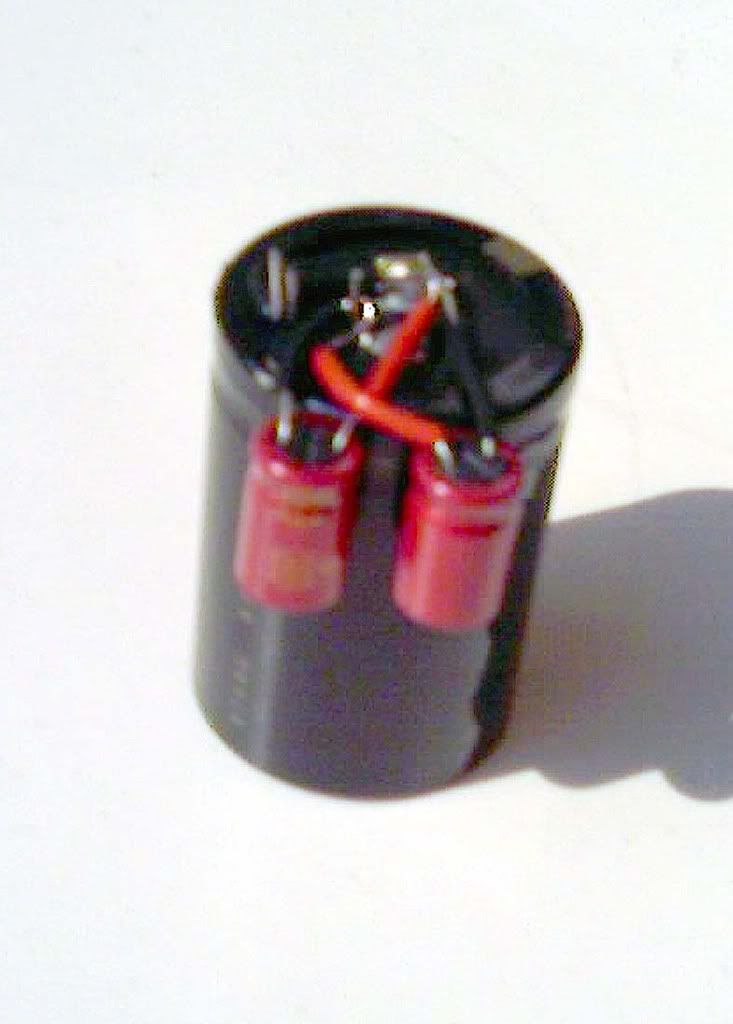 One smoothing cap with EC Super E-Caps resoldered back and with highlights ....... FROM ONE ANGLE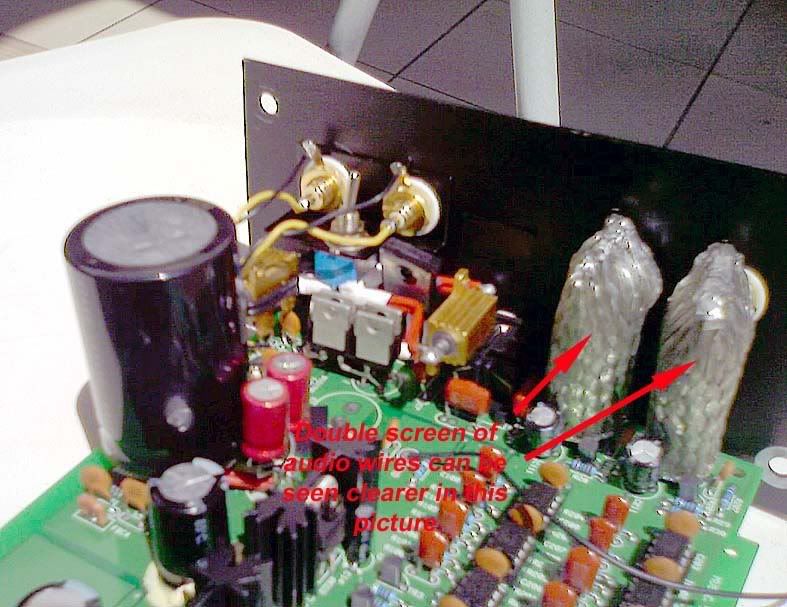 FROM ANOTHER ANGLE FROM ANOTHER ANGLE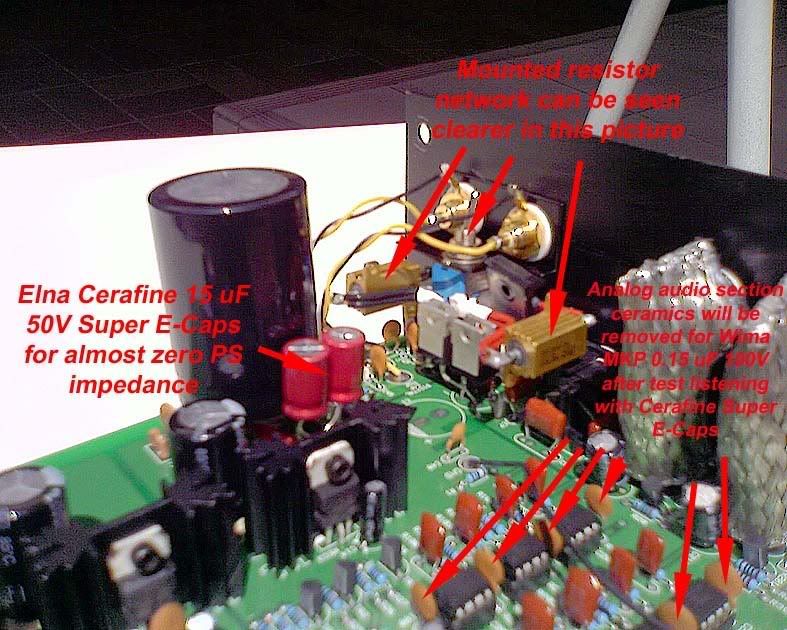 With both 12,000 uF soldered back ................. FROM ONE ANGLE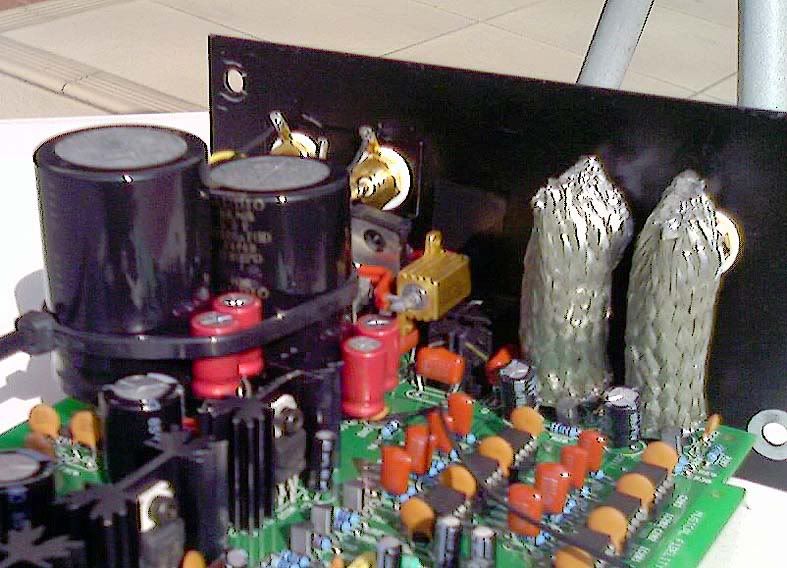 FROM ANOTHER ANGLE FROM ANOTHER ANGLE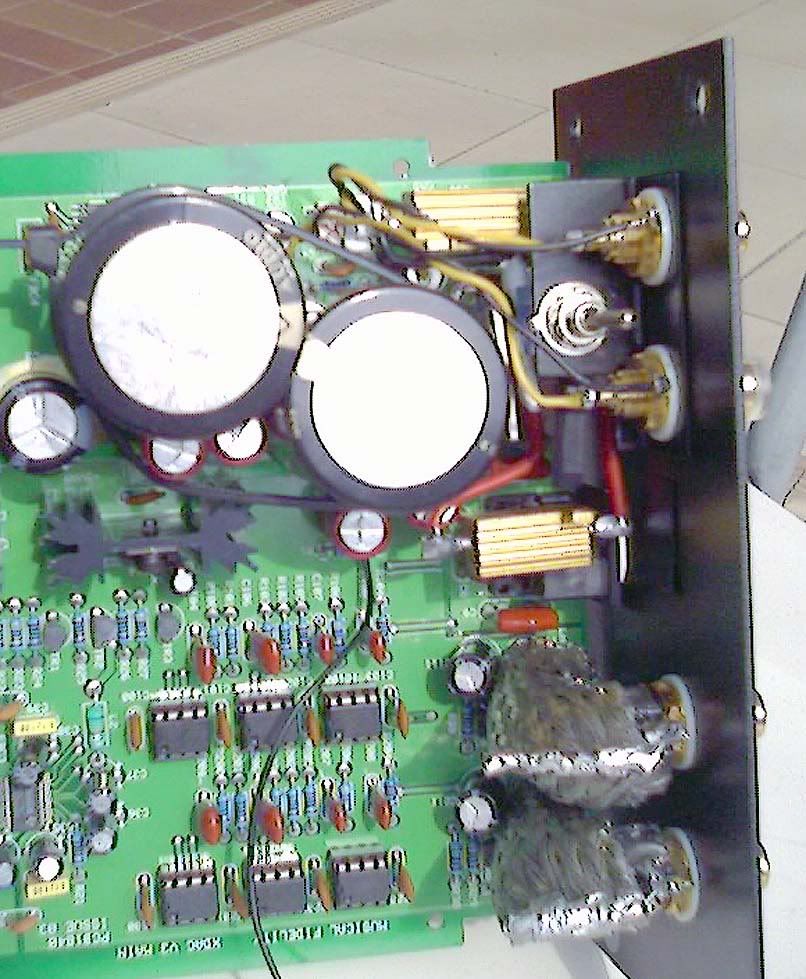 Hoped that my pictures are clearer now as I had tried my best to coax the Palm 750 digicam to produce better results.  And now the moment of truth and nothing but the truth ............ SQ1) WITHOUT EC SUPER E-CAPS After about a week of run-in for the Elna 12,000 uF smoothing caps at the max of around 16.8 max VDC that the 4562 opas can take, the bass had tightened up while still retaining the big volume and space that this mode had captured. The overall sound is smooth like the 2134 opas but without the super smoothness of those opas. What can I say but the extended high frequency of the 4562 with the smoothness of the 2134. Well, a hybrid sound, I would say. This I like. But somehow, with the resistors network in the supply path I don't feel as happy as when listening the same dac without. The overall magic seemed to have diminished somewhat by say about 5 to 10% but now substiuted with a very spacious and volumetric sound. Just imagine like listening to a valve amp that usually captures this very well but haven't just make it to that level yet.  The missing magic I'm talking about are like I can see the singer and can almost touch him/her, the emotions, interpretations and textures, the aliveness and the music gets up and going. The music seemed to have aged and become slower like Alex.  2) WITH EC SUPER E-CAPS Btw, to get this clear, the super E-Caps can only be achieved thru bipolar e-caps with proper so called + and - leads identification. Anything not biploar, you will have not super E-caps that can cancel the E-cap internal resonance to produce an almost zero impedance power supply. With these in, the magic I'm talking about started to migrate back and I'm now I'm happier. I would say now I'm getting the full 100% I'm getting before and with added space and volume to the sound. Zero sum game with a twist I would say.  Emm, come to think further, wouldn't say it's exactly a zero sum game as I'm now getting more volume and space. Still UNDER CONSTRUCTION? Ya, you bet. Check the killer mode I had done next. Ya..............................., killeeeeeeeeeeeeeeer!
|
|
XTRProf
Fully Modded
Pssst ! Got any spare capacitors ?
Posts: 5,689
|
Post by XTRProf on Apr 30, 2008 10:14:36 GMT
REPORTING PART SIXKILLER MODE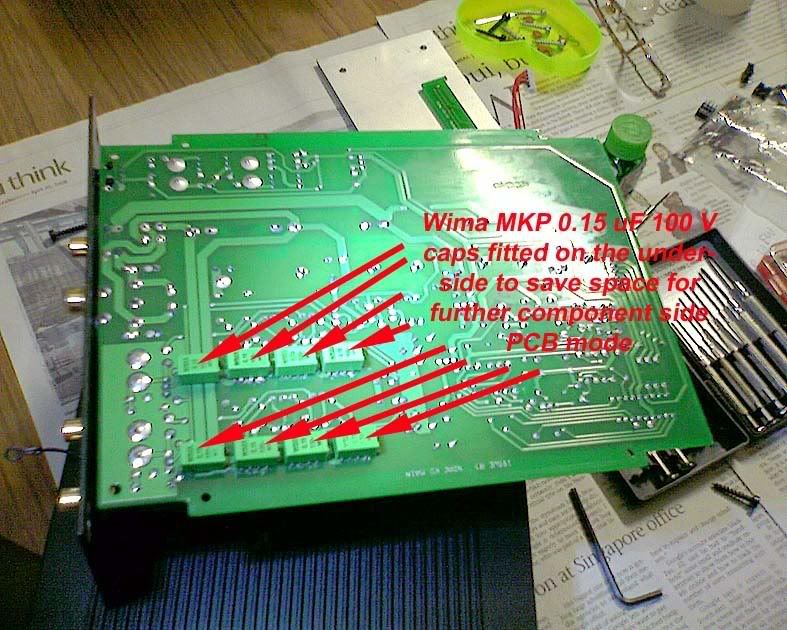 Why is this a killer mode at least in my system? Well, after replacing the 8 ceramic caps with Wima 0.15 uF 100 V MKP, the .................. SQ becomes:0) I'm again pulling CD after CD to compare and be critical again way passed midnight. Also, I would tend to switch the bloody system on most of the time when I have the time. This only happened when something great had happened to my system. 1) I'm dancing all the way in my usual listening position as I grined and grined all the way until my jaw dropped again. Wow, the space and volume became extremely 3 D. 2) The emotions and interpretations of the singers all of a sudden jump leaps and bounds over what I previously had experienced. 3) The flow of the music became extremely engaging and alive. Really, nothing had I experienced this level of sonic without going to listen to another of my friend megabuck super highend system. The overall sonic improvement by this was estimated at about 20 to 30% and I don't give high marks easily, btw. So now I'm going forward again in terms of sonic and not backward and I'm very happy now.   Power supply improvement works and I'm going to work on the power supplies around all the chips to super E-caps when I have the time again. Wow, I better be saving up for the BG NX BP. I just can't imagine what this will do further to the sound. Only thinking, btw, for BG as I may not have the funds for so many super E-caps the BG style. At least, I will work with EC super E-caps first.   So stick around until my next episode ................. 
|
|
XTRProf
Fully Modded
Pssst ! Got any spare capacitors ?
Posts: 5,689
|
Post by XTRProf on Apr 30, 2008 12:08:19 GMT
I revisited the calculation for the smoothing capacitance at 10% ripple based on actual measured values. The measured voltage dropped across the 2.5 ohm resistors were about 0.24 VDC each. So the actual current thru the resistors and thru the OPAs and the other rail with a 7805 regulator = 0.24 / 2.5 = 0.096 A. So the estimated of using 0.1 A (quisecent current) for the calculation is very close to correct. The recalculation found the cap needed for 10% ripple = (5 X 0.096) / (1.414 X 13)(50) = 5.22250027 X 10 to the power of -4 = 522.250027 uF. So even at 2,200 uF (the original as used in the MF Dac) the ripple will be more or less be only 1/4 of 10% = 2.5%. At 12,000 uF, the ripple will again be 1/6 of 2.5% = 0.4167% based on 4 significance figures. So the previously calculated facts based on unregulated at 12,000 uF still stand very closely. In fact, the ripple figure will improve further as now lesser current is drawn based on actual 0.096 A as compared with estimated 0.1 A.  I may reduce the 12,000 uF to about half (6,800 uF) and with the ripple about less than double at < 1% to see what the overall sonic signature will be later the true Zen Way when I have the time. I may have a better or worst sound that only Zen can tell me what's correct. No present measurements can tell you this, I can assure you.  |
|
Deleted
Deleted Member
Posts: 0
|
Post by Deleted on Apr 30, 2008 12:57:22 GMT
xtrprof
O.K. You now have reduced the , what frequency, ripple ?
Now how do these changes to such high priced components affect the flatness of the overall impedance over the range to >100KHZ ? Don't forget, its not all about residual hum, it's also about preventing interaction between the various sub sections, as well as providing a neutral sound , with no added warmth, no extra detail, OR break through of digital artifacts.
SandyK
|
|
XTRProf
Fully Modded
Pssst ! Got any spare capacitors ?
Posts: 5,689
|
Post by XTRProf on May 1, 2008 1:35:31 GMT
xtrprof O.K. You now have reduced the , what frequency, ripple ? Now how do these changes to such high priced components affect the flatness of the overall impedance over the range to >100KHZ ? Don't forget, its not all about residual hum, it's also about preventing interaction between the various sub sections, as well as providing a neutral sound , with no added warmth, no extra detail, OR break through of digital artifacts. SandyK Well, the 10% ripple formula for capacitance required is based on = (5 X current drawn) / (1.414 x VAC rms of secondary winding) (frequency we are talking about). So naturally we are talking of Singapore 230 VAC mains frequency of 50 Hz as we are former British colony. For US mains of 60 Hz, the cap required will even be smaller as now we have a bigger divisional base of 60 as when compared to 50 according to the maths, right? As the frequency domain is a divisor, the higher the frequency the lower will be the cap size required according to the formula. So let's us say 100 Khz or even the those nasty 1 to 2 MHz that can be in the mains to give us problem, the cap required will even be smaller. The frequency the higher the lower will be the ripple with a certain cap value, right? It jive with the same principle of as SMPS and that's why we need smaller cap in those PS. So we basically don't need to worry about high frequency ripple as at 12,000 uF, this will be almost none existence. Anyway, the EC BP caps are not high price. It's just SGD 2.50 for a 15 uF 50 V a pop. So I had only spent SGD 10 for 4. For the improvement in sound that I'm getting now, I think it's worth every cent of it. The BG may be even better as they are the best of the best in E-caps. Which device will give around -174 db of distortion level at lower frequency and about -120 db at higher? I don't think any active device used in the same manner can do that. That's the reason why passive devices are mostly better overall. Of course, there will always be some who will not think so as price is relative to everyone. I'll be using more later to beef up the local power around the chips. From this experience, the local PS beefing up around the chips are more important than those PS further up stream. Anyway, it's recommended in the application notes of the AD 8066 to have 4.7 uf each for the local + and - rails near the OPA. Are they wrong here when they show that diagram in the specs? As to the flatness of the impedance, impedance will vary with frequency whether passive or active. As for caps, the impedance is given by the formula = 1 / 2 pi f C. The bigger the C the lower the impedance at all frequencies. Also, the higher the frequencies the lower the impedance as well. As smoothing caps are basically low pass filters, the PSRR at higher frequencies will be better with higher cap value, right? Hmm, enough of text book maths again as I'm basically more Zen than Tech as that doesn't tell the whole story. But as it is, the sound is fantastic. Don't think it's not neutral. It's just like a 2134 without the extra smoothness thrown in and with a pleasing extremely 3D space and volume of the recording venue thrown in that surpass the 2134 many fold. The 2134 is poorly designed or rather the 4562 is poorly designed? I don't think so but just the matching, at least my system and ears, is not ideal for the 2134. There will again be always those who love them. Let me have some May Day music, shall we?  |
|
XTRProf
Fully Modded
Pssst ! Got any spare capacitors ?
Posts: 5,689
|
Post by XTRProf on May 9, 2008 12:51:23 GMT
REPORTING PART SEVENI was derailed for this whole week as I tried to get my senses back on track after my 6th uncle passed away (see my thread in the DSOTM section). So more of the modes that I had done till last Sunday before the derailment ...............  After the killer mode experience above, I'm extremely convinced that very good local PS is more important to sound then those further upstream. So I decided to venture further into beefing up local PS by removing the killer mode Wimas and improved on the local PS around the 6 OPAs with Elna Cerafine BP 15 uF 50 V. These Cerafine BP caps are next to the BG NX or NX Hi-Q BP std and are amongst the best of the best there are in E-Caps. I needed 8 here to replace the 8 ceramic 0.1 uF filter caps. Here is with the Wima removed ....................... 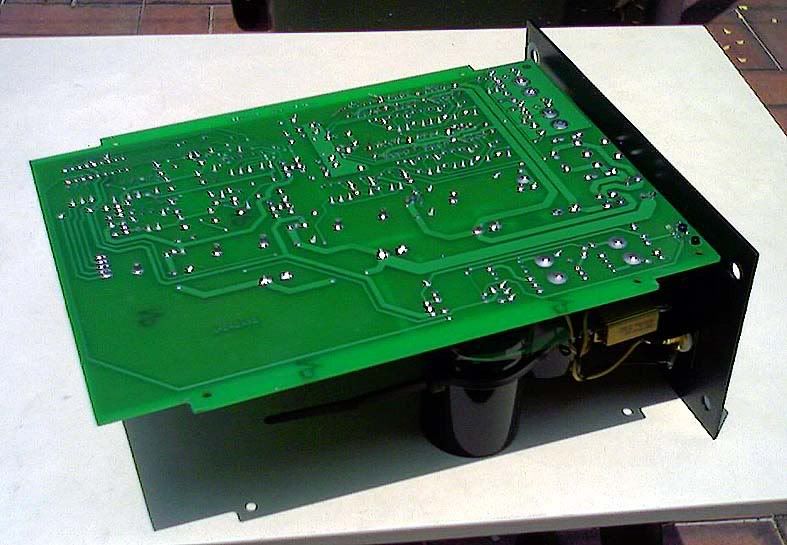 Here is with the EC Pseudo Super E-Caps soldered at the Ceramic cap places. Why pseudo Super E-caps? This is because the Super E-Cap connections are not exactly super yet. See my next picture for further details and note the pairing of the EC caps. Also, the orientation of the EC caps had been done with those 2 SO8 to DIP8 adapters in mind. Ya, those adapters were fitted and the EC caps orientation done with the least interference with those adapters if I have to use them like those BB 627, etc. I did not show the adapters fitted here when the orientation was done. So this is what it is ....................... 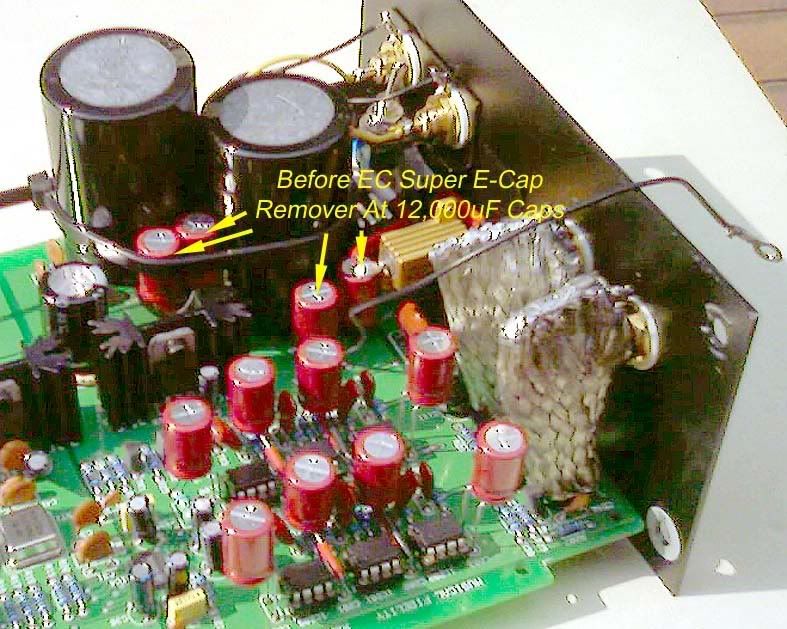 SQ: SQ: It is with pleasure, literally, to report the extreme 3 D became even more 3 D. But I wouldn't say as big a jump as the Wima. Say about 5 to 10% over the Wima depending on music genre used. So it's a smaller improvement and the bigger bang for the buck will be those cheaper Wima at about 50 cents each compared to the EC at SGD 2.50 each. If you can spare SGD 20 for 8 EC BP caps, I think it's still worth it when compared to having to spend thousands to upgrade equipment to this type of sound as described here. Btw, the Wima has a more spotlighted golden glow, like a well designed tube amp, and slightly less transparent sound when compared with the EC. The EC is more modern sounding like SS. So the next logical experiment was to take out those 4 EC Super E-Caps at the 12,000 uF as those were upstream to prove that local PS improvement is more important then those upstream. Here, is the picture ................  As you can see in this picture, the ECs are connected as in a Super E-Cap pairs style due to that possibility in the circuit traces of the X-Dac around the OPAs. But due to the slight difference in distance between the ECs to connect in a pair, the ECs are not exactly acting as in a Super E-Cap manner. The internal resonance cancellation will be there but not the ultimate as in a true Super E-Cap connection as shown in the BG websites. SQ: Yup, confirmed that there was not much noticeable difference without the EC Super E-Caps at the 12,000 uF caps. So the experience is correct that improvements in local PS is more important to sound then those PS improvements further upstream. So what next? To show that bypass at local PS will improve further the sound of the OPAs by putting back the Wima 0.15 uF 100 V MKP caps. Here's the picture ................. 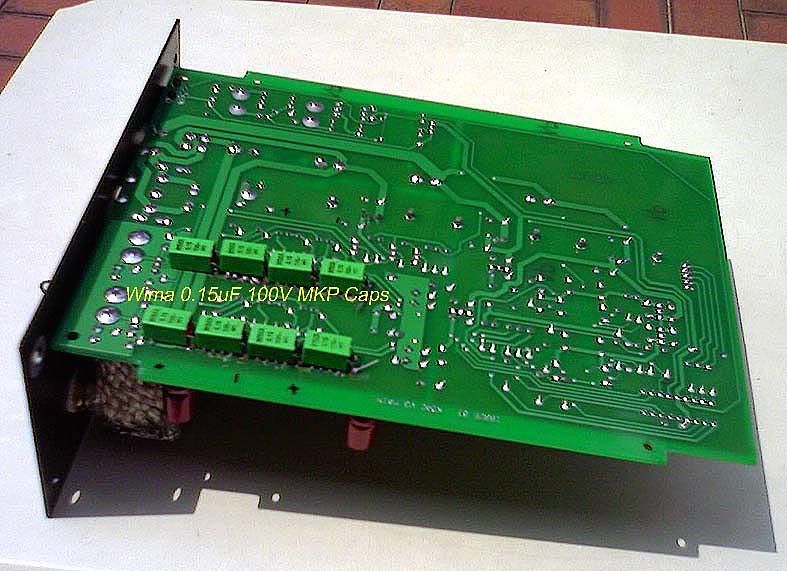 SQ: SQ: Nope, the sound became flappy and thick. Not my cup of tea at least. I would go as far as to say I'm going backward instead of forward. So out they will go. This I can guarantee you that present measurements will not capture and tell you why going backward here. Only real trial and error Zen will rightly tell you that. More to come as I take a break before coming back to report more as it's already 10pm now local time.
|
|
Deleted
Deleted Member
Posts: 0
|
Post by Deleted on May 9, 2008 13:00:37 GMT
XTRProf BTW, the ripple frequency is 100HZ,not 50HZ, as you are using full wave rectification .  SandyK |
|
XTRProf
Fully Modded
Pssst ! Got any spare capacitors ?
Posts: 5,689
|
Post by XTRProf on May 9, 2008 14:42:54 GMT
XTRProf BTW, the ripple frequency is 100HZ,not 50HZ, as you are using full wave rectification .  SandyK Heh, heh, heh ..................... Then my ripple will drop even further by half! (0.4167 / 2) = 0.20835%. And now with my Super E-caps of total 60 uF at the local PS per rail, this will again dropped further. I have no time to calculate now but will update with more calculations to show at least some calculatable parameters of what I had achieved now. Thanks for the update.  |
|
XTRProf
Fully Modded
Pssst ! Got any spare capacitors ?
Posts: 5,689
|
Post by XTRProf on May 9, 2008 14:56:11 GMT
REPORTING PART EIGHTSpur on by this present local PS thingy, I went further by "breaking" my bank account for 16 BG NX Hi-Q BP 0.1 uF 50 V caps to make the BG Super bypass E-Caps to replace the taken out Wima bypass caps. But luckily for me those were not that expensive as first thought as they are low value caps. It only cost about SGD 3 a pop and so SGD(16 x 3) = SGD 48 total. But that's still expensive but I don't see anything on e-caps better than this technically. Just imagine a claimed distortion of about -174 dB at lower frequencies and -120 dB at higher frequencies in the kilo and megahetrz range. No available active devices can match this passively currently. Even the measuring instruments have to used these before the BG distortion figures can be measured, unlike measuring other devices.  So with the first trial, naturally the BG was in a pseudo Super E-Cap manner as shown in the next picture ................. 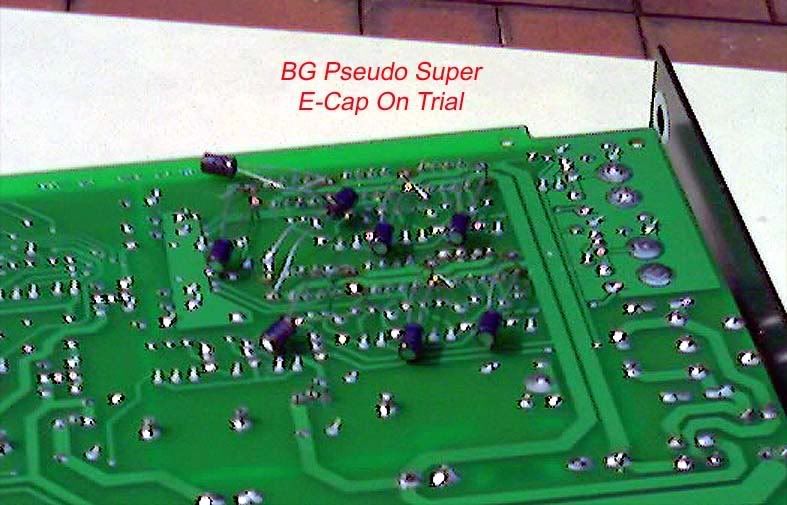 SQ: SQ: The sound became airy, super clear, mechanical and bright. I wouldn't say it's not my cup of tea as I like airy and clear sound but not super clear, mechanical and bright type of airy. So temporary with held this as I go on to connect the true BG Super E-Caps trial. So here's the true BG Super E-caps connection. Before that I had to correctly dress the pseudo connection before the true connectiion could fit ........................  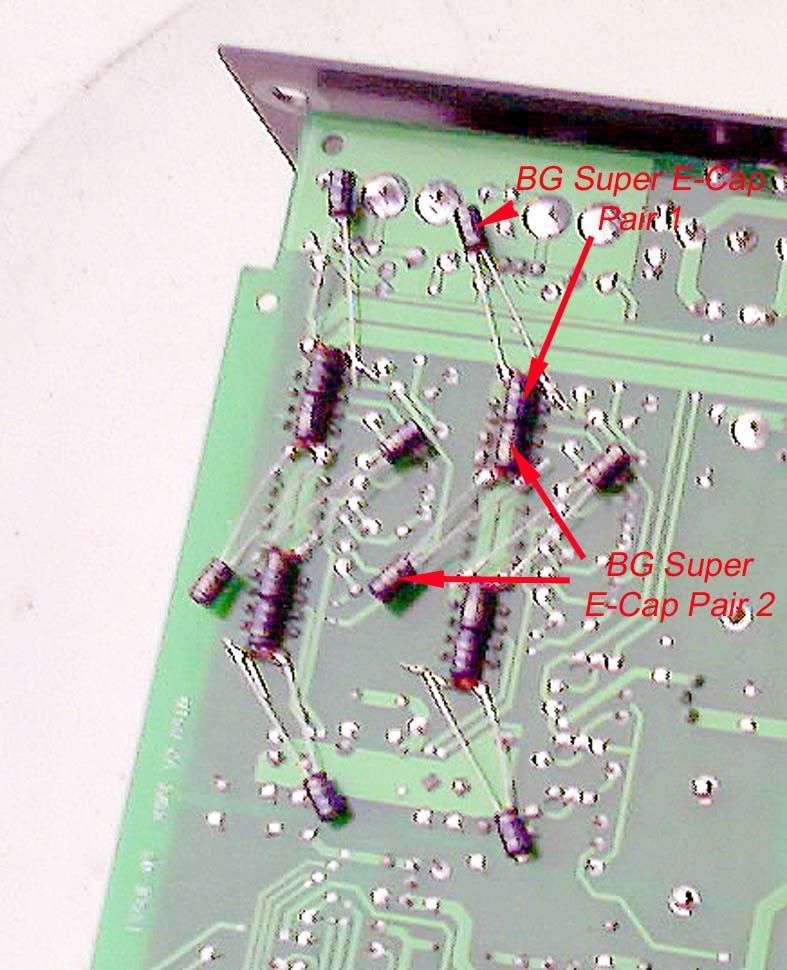 SQ: SQ: Yukes! The sound became blur and thick. I would say I'm going backwards by some 10 to 15% and I don't like it. So this will go if the next connection didn't improve on things. The next was go for the full monty of true Super E-Caps of EC and BG. But since I don't have enough of the EC caps, as I only had on hand the 4 from the EC Super E-Caps taken out from the 12,000 uF, I did a half job just to see how it will sound. These are the pictures of that story ...................... 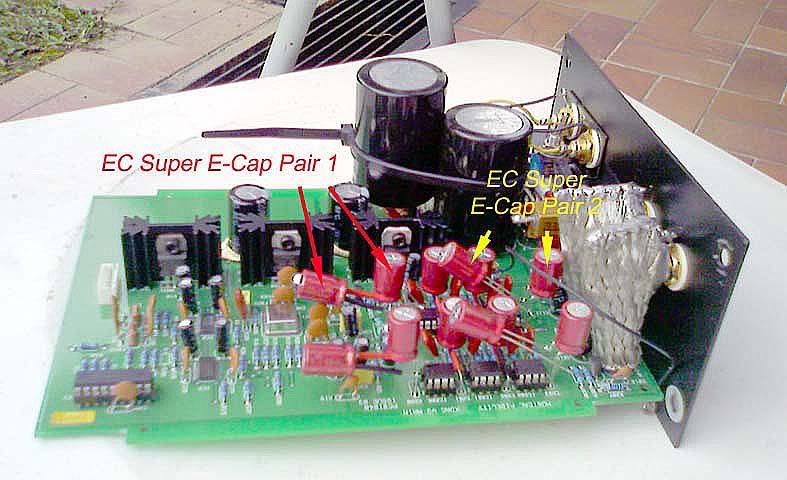 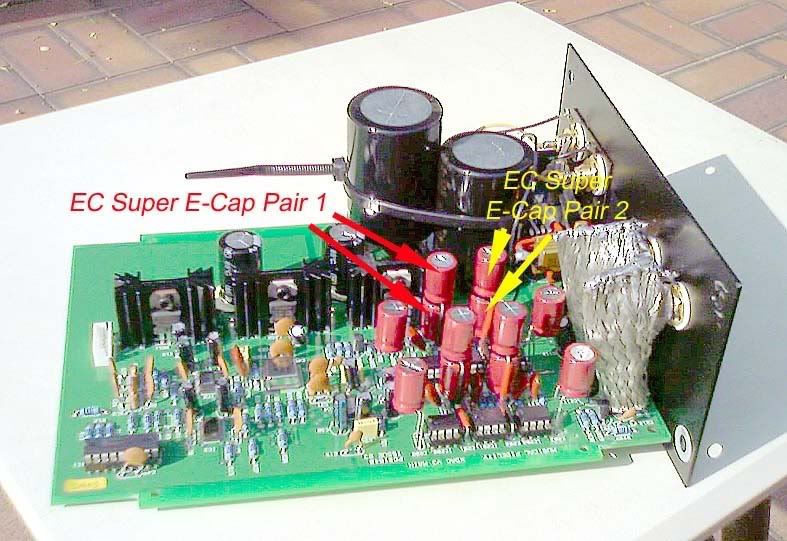 SQ: SQ: Wow, the sound improved from blur and thick to something so clear like I'm just looking thru a window into the recording space. Yes, yes, this is definitely an improvement and going forward. Overall, I would say the improvement from the very first mode to here is about 35 to 40% depending on the music used. Yet, again this is something no present technical measurements will tell you why except thru Zen. Perhaps, one technical accountability is that adding the other caps upset the internal resonance cancelling of the BG and EC Super E-caps. If not done in a true or pseudo balanced manner the sound will sound shitty. That is why the closer to pseudo and true Super E-Cap combinations, the X-Dac will always sound the best from the various combinations if we investigate and recollect from the experiences. That's all folks as I need to rest now since it's already pass midnight local time ......................... 
|
|
Deleted
Deleted Member
Posts: 0
|
Post by Deleted on May 9, 2008 21:41:16 GMT
That is utter BS !  SFW ! ???That may have some importance if they are being used as coupling capacitors. Even then, there are even better capacitors available. Their primary function in this application is to provide a very low impedance for the power supplies, that has no major dips or peaks, in the frequency range from as few HZ to several hundred KHZ. Due to having a resonant frequency, no single capacitor is capable of that.The closest you can get is with carefully chosen parallel combinations of many capacitors , and you will still have an impedance "ripple" SandyK |
|
XTRProf
Fully Modded
Pssst ! Got any spare capacitors ?
Posts: 5,689
|
Post by XTRProf on May 10, 2008 3:28:57 GMT
BS = Bachelor of Science ? Nope, Bachelor of Sound!  Don't worry, I will do some more technical maths to show more parameters on what I had done when I have the time. That will be Bachelor of Engineering stuffs. But sorry folks, please do pardon me for the present as I have forgotten most of the formulae and had not done engineering math calculations for umpteen years after college. Hmm............, that was roughly in the early 80s. Wow, that was about 25 years ago. So let me get up to speed first, will you? Danke .....................  |
|
XTRProf
Fully Modded
Pssst ! Got any spare capacitors ?
Posts: 5,689
|
Post by XTRProf on May 10, 2008 3:49:25 GMT
SFW ! ???That may have some importance if they are being used as coupling capacitors. Even then, there are even better capacitors available. Their primary function in this application is to provide a very low impedance for the power supplies, that has no major dips or peaks, in the frequency range from as few HZ to several hundred KHZ. Due to having a resonant frequency, no single capacitor is capable of that.The closest you can get is with carefully chosen parallel combinations of many capacitors , and you will still have an impedance "ripple" SandyK Err, can you tell me what is the better e-caps than BG and EC BP? I will want to buy some too if I can afford them. Yes, E-Caps and nothing else ..............  Also, paralleling e-caps will not give Super E-Caps unless they are BP. So no resonance cancellation thru just paralleling any e-caps. For more and clearer details to all, if interested in technical stuffs, check here to form your educated opinions against said.  |
|
XTRProf
Fully Modded
Pssst ! Got any spare capacitors ?
Posts: 5,689
|
Post by XTRProf on May 10, 2008 4:02:50 GMT
Ok, back on track ..................... I have done a draft of the circuit for the analogue side of the DSD 1792 dac chip to try to understand it's functions to try to boost up the local PSs there as well this morning. Sorry again here for the unprofessional diagram as I don't have a circuit diagram software to draft this. So here is the circuit .............. 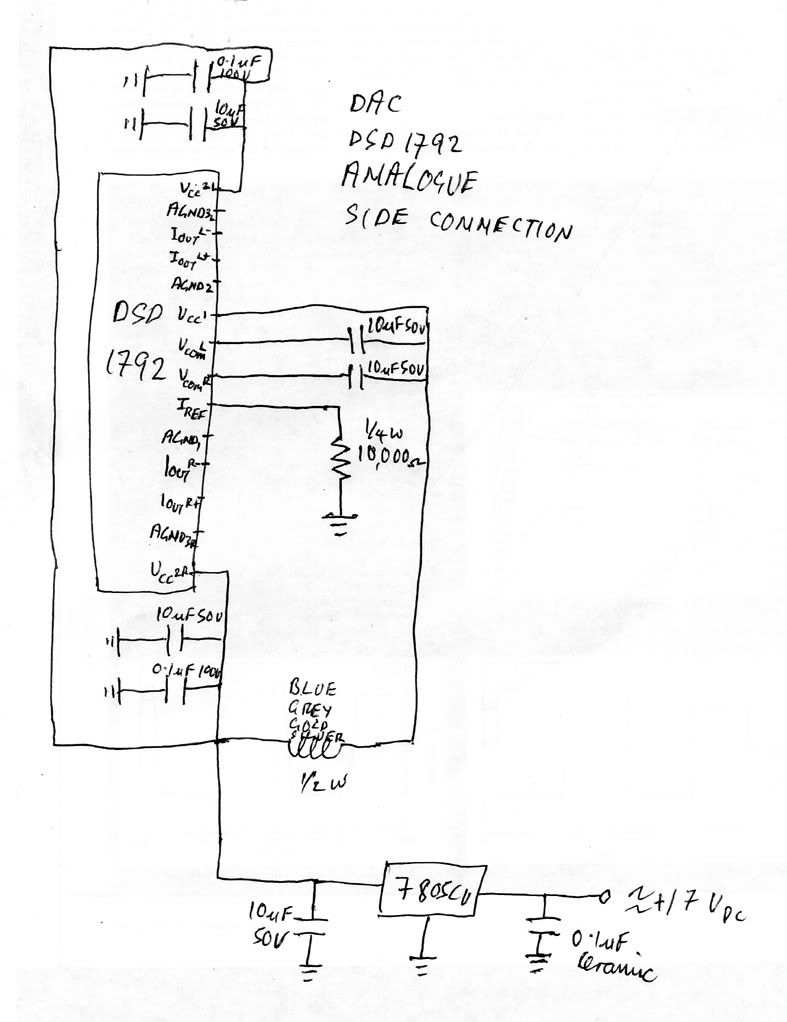 The question I like to ask is what are VcomL and VcomR with a 10uF coupling e-cap each for? Leo, are you watching this? Please help. Thanks. Also, what's this? ............... 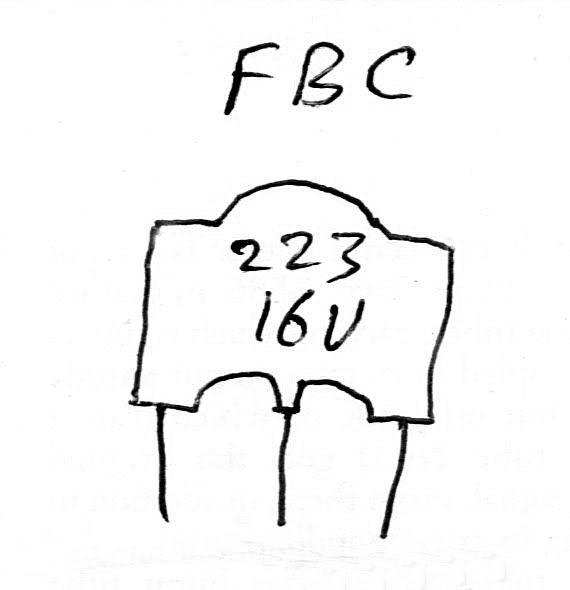 |
|
Deleted
Deleted Member
Posts: 0
|
Post by Deleted on May 10, 2008 4:55:07 GMT
XTRProf
BG are talking about INTERNAL resonance which causes a change in impedance as frequency rises. A typical 470uF capacitor has a broad resonance around 4-5KHZ (according to a graph from JLH) Think about it ! Capacitive Reactance = 1 /2pi FC Where C is in Farads.
OR 1,000,000/2pi FC Where C is in uF.
I have emailed you some PCM 1792 data
Alex
|
|
XTRProf
Fully Modded
Pssst ! Got any spare capacitors ?
Posts: 5,689
|
Post by XTRProf on May 10, 2008 5:13:03 GMT
I have emailed you some PCM 1792 data Alex Gee, thanks Alex! I have also PM Leo to help out in this.  |
|
XTRProf
Fully Modded
Pssst ! Got any spare capacitors ?
Posts: 5,689
|
Post by XTRProf on May 10, 2008 5:20:37 GMT
Since I have some time now before going out at about 4pm, I guess I just consolidate some technical parameters and thoughts to share with all here wrt to what I had done for your educated judgements: FACT 1: 10 % ripple formula for smoothing cap = (5 x current drawn) / (1.414 x VAC rms of secondary winding) (frequency we are talking about) = (5 x 0.096) / (1.414 x 13) (100) = 2.611250136 ^ -4 = 261.1250136 uf = 261.1250 uf to 4 decimal places So 12,000 / 261.1250 = 45.9550 times and the ripple percentage for each of my 12,000 uf smoothing cap = 10% / 45.9550 = 0.2176% based on 4 significance figures FACT 2: Since the local PSs at the 6 OPAs are beefed up by the BG and EC Super E-Caps to 60 uf each rail, when I have all of them fitted in the true Super E-Caps manner, there will again be some smoothing down there when the 0.2176% ripple arrived there. The ripple % arriving = (ac / dc) (100) So rearranging, ac at local OPA PSs = (0.2176 / 100) (16.82) = 0.0366 Vac based on 4 significant figures The Time Constant t = 1 / f Based on 100 Hz, t = 1/ 100 = 0.01 s C required = (I / Vac) (T) Therefore, C required = (0.096 / 0.0366) (0.01) = 0.026229508 F = 26.2295 uf based on 4 deciomal places But for 60 uf, that will be = 60 / 26.2295 = 2.2875 times The ripple at the local OPA PS = 0.0366 / 2.2875 = 0.016 Vac Ripple % at local OPA PSs is about = (0.016 / 16.82) (100) = 0.09512 % to 5 decimal places FACT 3: Based on the same link as above on BG caps here and from that graph of Fig 5 there, ESR for Super E-Cap for 100V 2,200 uf = 0.0108 ohm at 100 Hz and going below to as low as 0.0011 ohm at 1 MHz. Sorry this is approximate as the graph is just too small to interpret correctly. Impedance for Super E-Cap for 100V 2,200 uf = 0.13 ohm at 100 hz and going down all the way to 0.00125 ohm at 1 MHz. Again, only approximately as the graph is just too small to interpret it correctly. FACT 4: Here is some comparisons of SMPS vs Regulated vs Unregulated. Please take note of the Transient Recovery. As unregulated doesn't go thru Vregs (some transistors, resistors, etc make these up), there is not recovery on transient needed for literally transient needs of the amps. For SMPS and regulated, the transient recovery time is 50 to 300 ms. So there is inevitably going to be some "switching" noises generated as the transistors hunt to generate the correct voltages based on the reference. So dynamics will be better for unregulated since zero recovery like Schottky diodes. Also, since unregulated doesn't have the Vregs to generate noises and other artefacts of active devices as well as blocking the supply, the PS should technically on paper be quieter and more musical sounding. FACT 5: Most know KISS is always better sounding when it does the job correctly. KISS designs in most cases will sound better than complicated designs. Hence, we have things like audiophiles going back to vinyl, tubes, NOS dacs, SET and full range speakers. Heh, heh ......... I still remember one of my lecturers telling the cohorts why have an engine when you can have the donkey to do the job. That time we were too young to understand that but now KISS everywhere, man! Only no KISS when it comes to KISS the rock group!  Enough for now as I need a rest. I'll be back for more technical parameters when I have the time to recollect some of those engineering formulae and how to calculate from the past.  Boy, is this tough now as I just haven't touch these stuffs for donkey years, man! But I'm liking it as I relive my student days now. I rest my case and let you decide what is right or righter for your applications.  |
|
Deleted
Deleted Member
Posts: 0
|
Post by Deleted on May 10, 2008 5:55:58 GMT
XTRProf
Is the added 60uF of capacitance at each supply rail of the I.C. , AFTER the dropping resistor ?
In that case they will only have a minor effect, as at 20HZ, their capacitive reactance is around 130 ohms !
Alex
|
|